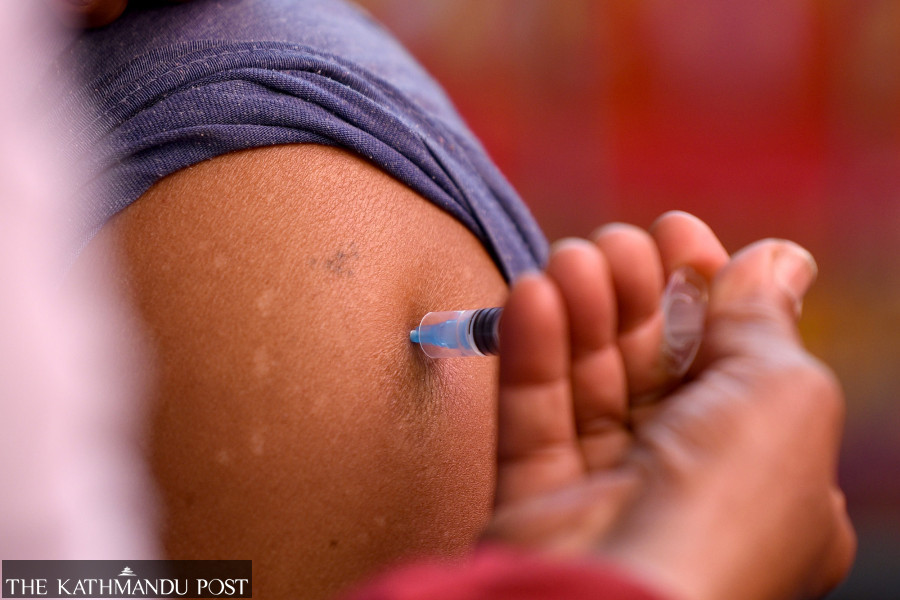Health
Vaccination drive halted in some districts since November
A lack of sufficient doses and accessibility to health care centres, as well as adverse weather conditions, are some factors that have hampered the ongoing immunisation campaign against Covid, officials say.
Arjun Poudel
The number of people seeking vaccination has risen in Durgathali Rural Municipality of Bajhang district due to the requirement of mandatory vaccination proof to use public amenities.
However, the rural municipality has not administered Covid-19 vaccines since November due to a lack of doses.
“We do not have any vaccine to administer to the people who have not taken any doses yet. Neither do we have the vaccine to administer the second doses,” Hansa Raj Dulyal, a health worker serving at the rural municipality, told the Post over the phone from Bajhang. “Around a half of the local unit’s population is yet to receive a vaccine but we do not have any doses left.”
When the vaccines were piling up in the central and provincial stores, the Ministry of Health and Population urged all agencies to ramp up the vaccination drive. The minister for health and population himself held meetings with stakeholders, including the chief district officers, across the country and sought their help to step up the drive.
But the reality is—the local units of Bajhang have halted the vaccination drive citing the shortage of doses.
Health workers serving in the district say they are collecting data on the people who have yet to receive a vaccine. The data will be furnished to the provincial office to demand doses.
“We have used up our stock to vaccinate schoolchildren and provide booster shots. Now we don’t have any doses left to administer the first and second doses,” said Dulyal.
A lack of sufficient doses, adverse weather conditions and inaccessibility of health care centres are some of the factors that have hampered the ongoing Covid-19 vaccination in the district, officials say.
On Friday, the District Hospital of Humla could not continue its Covid-19 vaccination programme due to heavy snowfall with temperatures plunging to minus seven degrees Celsius.
Health authorities were struggling to maintain the cold chain for the vaccine due to power disruption.
“We have been using a diesel generator to maintain the temperature in the cold room,” Dr Tashi Lama, chief of the District Hospital, said over the phone from Humla. “Operating the generator is not easy as it takes over two hours to start the machine due to cold.”
The Humla Hospital is the only centre in the district for Covid-19 vaccination. Due to its inability to maintain the vaccine supply, the hospital halted its inoculation drive a few months ago.
“Despite all the adversities and difficulties, people in Humla are seeking vaccines against Covid-19,” said Lama. “Every day, over 300 people visit the hospital for the jabs but it has not been easy to continue the programme due to the adverse weather.”
The immunisation drive against Covid-19 has also been affected in many other mountain districts due to the cold and inaccessibility of vaccination centres.
Despite numerous obstacles, Nepal’s vaccination programme has been gaining momentum. As of Saturday, 15,482,087 people, or 53 percent of the total population, have been fully immunised.
Public health experts say that Nepal’s vaccination programme could have achieved better results had the authorities concerned addressed some obstacles seen at the local level.
“To make the programme successful and increase the vaccine coverage, micro-level planning is needed,” said Dr Jhalak Sharma, former chief of the National Immunisation Programme. “Authorities have made micro plannings but if problems arise, they should be addressed immediately.”
It has been over a year since the Covid-19 vaccination drive was launched but the authorities have yet to make provisions for inoculating the disabled and bed-ridden people who are unable to reach immunisation centres. The authorities have also failed to set up new vaccination centres in rural areas to expand vaccine coverage.
“There is only one Covid-19 vaccination centre in our rural municipality,” said Dulyal from Bajhang. “People have to walk for up to three hours to reach the vaccination centre. This has made it difficult for many people to receive the shots.”
Meanwhile, officials at the Ministry of Health and Population say they are unaware of a halt in vaccination due to the lack of doses.
“We have been asking all the agencies concerned to facilitate the vaccination drive,” said Dr Samir Kumar Adhikari, joint spokesperson for the Health Ministry. “I am not aware of any centre halting vaccination for the lack of jabs.”
Adhikari, however, concedes that vaccination may have been discontinued in some places due to factors like problems in maintaining vaccine cold chain and supply and adverse weather conditions.
“If any centre has run out of vaccines, they should coordinate with the respective provincial offices,” said Adhikari.
Nepal so far has received 45,737,840 doses of vaccines, including AstraZeneca, Vero Cell, Moderna, Janssen and Pfizer-BioNTech.
On Saturday, 1,714 people tested positive—1,103 in 5,225 polymerase chain reaction tests and 611 in 3,288 antigen tests. In the last 24 hours, nine people died due to complications related to Covid-19. Active cases stand at 52,780.




 18.12°C Kathmandu
18.12°C Kathmandu














